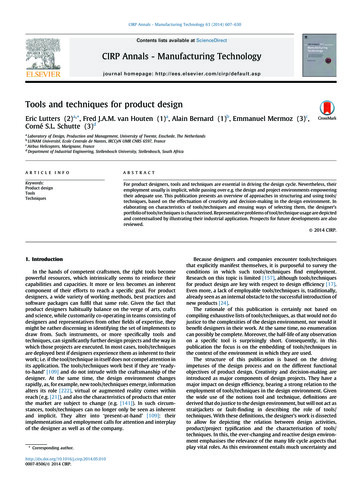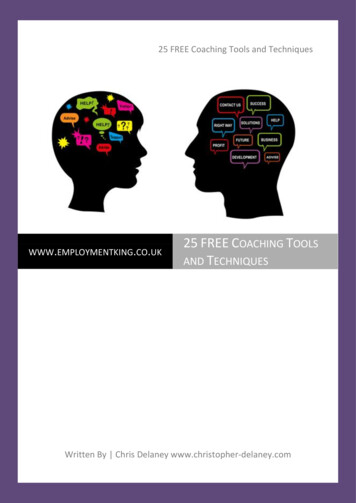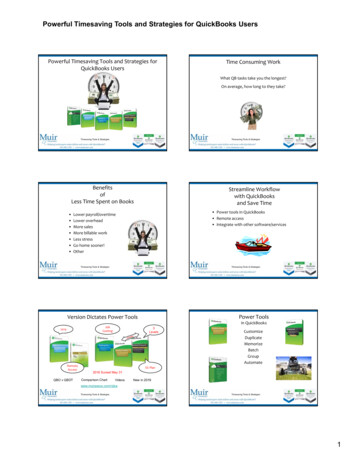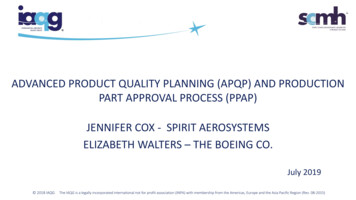
Transcription
CIRP Annals - Manufacturing Technology 63 (2014) 607–630Contents lists available at ScienceDirectCIRP Annals - Manufacturing Technologyjou rnal homep age : ht t p: // ees .e lse vi er . com /ci r p/ def a ult . aspTools and techniques for product designEric Lutters (2)a,*, Fred J.A.M. van Houten (1)a, Alain Bernard (1)b, Emmanuel Mermoz (3)c,Corné S.L. Schutte (3)daLaboratory of Design, Production and Management, University of Twente, Enschede, The NetherlandsLUNAM Université, Ecole Centrale de Nantes, IRCCyN UMR CNRS 6597, FranceAirbus Helicopters, Marignane, FrancedDepartment of Industrial Engineering, Stellenbosch University, Stellenbosch, South AfricabcA R T I C L E I N F OA B S T R A C TKeywords:Product designToolsTechniquesFor product designers, tools and techniques are essential in driving the design cycle. Nevertheless, theiremployment usually is implicit, while passing over e.g. the design and project environments empoweringtheir adequate use. This publication presents an overview of approaches in structuring and using tools/techniques, based on the effectuation of creativity and decision-making in the design environment. Inelaborating on characteristics of tools/techniques and ensuing ways of selecting them, the designer’sportfolio of tools/techniques is characterised. Representative problems of tool/technique usage are depictedand contextualised by illustrating their industrial application. Prospects for future developments are alsoreviewed.ß 2014 CIRP.1. IntroductionIn the hands of competent craftsmen, the right tools becomepowerful resources, which intrinsically seems to reinforce theircapabilities and capacities. It more or less becomes an inherentcomponent of their efforts to reach a specific goal. For productdesigners, a wide variety of working methods, best practices andsoftware packages can fulfil that same role. Given the fact thatproduct designers habitually balance on the verge of arts, craftsand science, while customarily co-operating in teams consisting ofdesigners and representatives from other fields of expertise, theymight be rather discerning in identifying the set of implements todraw from. Such instruments, or more specifically tools andtechniques, can significantly further design projects and the way inwhich those projects are executed. In most cases, tools/techniquesare deployed best if designers experience them as inherent to theirwork; i.e. if the tool/technique in itself does not compel attention inits application. The tools/techniques work best if they are ‘readyto-hand’ [109] and do not intrude with the craftsmanship of thedesigner. At the same time, the design environment changesrapidly, as, for example, new tools/techniques emerge, informationalters its role [222], virtual or augmented reality comes withinreach (e.g. [21]), and also the characteristics of products that enterthe market are subject to change (e.g. [141]). In such circumstances, tools/techniques can no longer only be seen as inherentand implicit. They alter into ‘present-at-hand’ [109]: theirimplementation and employment calls for attention and interplayof the designer as well as of the company.* Corresponding 00007-8506/ß 2014 CIRP.Because designers and companies encounter tools/techniquesthat explicitly manifest themselves, it is purposeful to survey theconditions in which such tools/techniques find employment.Research on this topic is limited [157], although tools/techniquesfor product design are key with respect to design efficiency [17].Even more, a lack of employable tools/techniques is, traditionally,already seen as an internal obstacle to the successful introduction ofnew products [24].The rationale of this publication is certainly not based oncompiling exhaustive lists of tools/techniques, as that would not dojustice to the complexities of the design environment, nor would itbenefit designers in their work. At the same time, no enumerationcan possibly be complete. Moreover, the half-life of any observationon a specific tool is surprisingly short. Consequently, in thispublication the focus is on the embedding of tools/techniques inthe context of the environment in which they are used.The structure of this publication is based on the drivingimpetuses of the design process and on the different functionalobjectives of product design. Creativity and decision-making areintroduced as major components of design projects. They have amajor impact on design efficiency, bearing a strong relation to theemployment of tools/techniques in the design environment. Giventhe wide use of the notions tool and technique, definitions arederived that do justice to the design environment, but will not act asstraitjackets or fault-finding in describing the role of tools/techniques. With these definitions, the designer’s work is dissectedto allow for depicting the relation between design activities,product/project typification and the characterisation of tools/techniques. In this, the ever-changing and reactive design environment emphasises the relevance of the many life cycle aspects thatplay vital roles. As this environment entails much uncertainty and
608E. Lutters et al. / CIRP Annals - Manufacturing Technology 63 (2014) 607–630ambiguity, their influence on tool/technique employment isillustrated. To contextualise characterisations of tools/techniques,exemplary industrial embedding is described. Based on the overviews given in this publication, future developments will beproposed and commented upon from the application, researchand development viewpoints for tools/techniques.1.1. ScopeAlthough much of the reasoning in this publication is applicableto a wide variety of product types, the background of the workpresented here stems from an environment that aims atengendering discrete, physical products. For example, the reasoning might well be applicable to the (integrated) design of services[166,185,211] or even the processing industry; however, thewording and terminology is geared to and based on design cyclesfor discrete products. In this, focus is explicitly on the design ofthese discrete products, rather than on the ensuing engineeringtasks covered by product development.Nevertheless, even for these discrete products, the staggeringamount of existing products immediately illustrates that it would bean endless task to group products according to ‘classical’ productclassification methods (e.g. [132,192]). Even more elaborateclassification methods (e.g. [251]) are only appropriate for a specificdomain of the entire range of products. Consequently, another wayto classify products is required. Rather than function, geometry,material, required processes, etc. this typification is based on moreabstract properties of products. However, in this case, a relevant setof appropriate properties has to be selected, in order to avoid thehazard of arriving at an infinitely large set. In literature, ampleattention has been paid to this problem, with varying results. Animportant contribution [117] values the mutually independenceconstraint of the properties of so-called technical systems. Acategorisation of properties and a ‘model of models’ (based on[198]) is used to arrive at the co-ordinate system in the model shownin Fig. 1.Novelty manifests itself in unconventional ideas, features andconceptual combinations that ‘are not obvious from the state of theart’, whereas maturity relates to the firmness of a system design.Complexity is interpreted in direct relation to risk of failure.Evolution of systems, in terms of the model, tends towards lowernovelty, higher complexity and higher maturity.Fig. 1b shows an alternative [225] where the evolution ofproduct development is related to the competitive insistence onhigher quality, increasing complexity and lower lead times. As thedetermination of the quality of products in general is rathersubjective, this property might be a fragile basis to compare andclassify different (types of) products. Moreover, the lead-timeprobably is more an indication of the production process and itsorganisation than of a product.These two deficiencies have been overcome by selecting adifferent perspective. Reasoning not from the manufacturer, butfrom the customer, the product can be valued against its directrequirements. This allows for the same approach of independentproperties, however, the selection of properties is partiallydifferent (see Fig. 1c). The first property is complexity, basicallyindicating the same property as in Figs. 1a and b, but withemphasis on the complexity pending the entire product life cycle(i.e. during manufacturing, maintenance, repair, recycling, etc.). Basedon the different ways in which customer-supplier relationshipsFig. 1. Different ways to characterise products.[59] and the customer-order decoupling point (see e.g. [139,190,209])can be modelled, the adaptability of products can directly be used.The third property is the quantity of products.2. Problem solving, creativity and decision-makingThe design of products is, and will always be, an act ofcraftsmanship. It is characterised by the ability to repeatedlyemploy problem solving, creativity and decision-making in acontrolled and efficient manner to reach an adequate productdefinition. In this, the balance between creativity and systematicapproaches strongly depends on the type of product (see Fig. 1),where the difference between routine and non-routine design aswell as between incremental and breakthrough innovations plays animportant role [83,87].2.1. CreativityIrrespective of the context, the team involved and the tools,techniques, methods and frameworks that support the designteam, it will always be the ingenuity and inventivity of thedesigners that provide for and ignite the creative sparks thatdecisively discern individual product development cycles. Withthis, designers are really at the heart of product development. Thisis all the more true, because the product design cycle consists of aset of activities that has no equivocal starting point; it has a resultthat is not known on beforehand and that is reached by a trajectorythat is capricious. Therefore, a design cycle thrives on creativity asthe main propulsion mechanism, producing the vital incentive forthe evolution of the product definition that goes with the headwayof the product development project. Consequently, creativity is thecause of progress in development cycles, but may simultaneouslyhamper the predictability thereof.Infused by the unique role it has in development cycles,literature addresses the phenomenon ‘creativity’ from a variety ofviewpoints, ranging from cognitive aspects [33,140], via experience [7,116], team work [250] to educational aspects [61,144] andinvestments [229]. Resulting from a detailed study of definitions ofcreativity [35] is the definition: ‘‘creativity occurs through aprocess by which an agent uses its ability to generate ideas,solutions or products that are novel and valuable’’.What seems to be a common factor in most literature oncreativity is a focus on its realisation: preconditions, means,environment and challenge. Also, the differences between ‘personal’and ‘social’ views on creativity – depending on who perceives thenewness and usefulness – are recognised [163]. A discernment thatis contributive from the perspective of the overall design cycle is thedichotomy between the ‘content’ of creativity and its ‘structure’. It isevident that a designer will always observe the coherence betweenthe mechanisms of creativity and the subjects these mechanisms areapplied to. Junior designers might explicitly struggle with this split,whereas experienced designers might have grown to implicitlyvalue the amalgamation of the two.For design teams, it is impossible to adequately tackle a designcycle and have a meaningful overview over the design tasks if thecontent and structure of the work are too intertwined.Creativity is a means to an end: it explores beyond the frontiersof the current product definition. The results of such explorationsare contributive, much more than the initiatives that caused thoseresults to be achieved. Consequently, creativity is not the onlyprecondition for progress in development cycles: the possibilitiesopened up by creativity must be assessed, elaborated andincorporated in the overall design cycle to make actual headway.Moreover, it is the progress in the design cycle that determines ifthere is room and demand for a next creative step [248].The progress in design cycles is characterised by the myriaddecisions taken by members of the design team (and selected otherstakeholders) that subsequently, concurrently, conjointly but alsocontradictorily raise the extent and level of the product definition(see Fig. 2 [182]). All these decisions, in a sense, are the building
E. Lutters et al. / CIRP Annals - Manufacturing Technology 63 (2014) 607–630609Fig. 3. Decisions analysis cycle.Redrawn from [115].Fig. 2. Decision process in the context of business and environment.Redrawn from [182].blocks that construct the design cycle [106,107,111,143]. Obviously, creativity is merely one of the occasions for design decisionsto be made; decisions can (or need) also be made following a widevariety of other causes, ranging from changed circumstances oraims, via new insights or simulation results, to sheer routineproject advance. Even in such cases, often quite some creativity isinvolved in preparing an adequate decision context, i.e. a situationthat allows for reaching a well-underpinned decision. Thisbecomes all the more relevant in observing that most decisionscannot be taken based on complete, correct, flawless, unequivocal,transparent and objective information, criteria and aims. Consequently, at the prevailing status of the product definition, it isextremely difficult to adequately determine effective and efficientnext steps to consolidate the right prospects with their varyingconsequences and scopes. Especially pre-sorting the tactical andstrategic directions for design steps against the prevailing status ofthe product definition in the available design environment rendersthe design cycle a complex and challenging set of activities [73].2.2. Decision makingDecision-making, not only in general, but also for productdesign has been the topic of many studies ([5,28,102,227,243]).Given the complexities sketched in the above, it is understood thatthe many different points of view that exist prevent the emergenceof one unequivocal model for decision-making. As a commondenominator, formally, decision-making can be regarded as the actor process of consideration and deciding, resulting in a conclusionor resolution especially as to future action [51].In design, the activity of decision-making arises from the need toselect the best possible course of action (or a set of optimisedactions) from a set of alternatives [124]. Exploration and development of alternatives is typically an integral part of the decisionmaking process. Often this is not a separate step but is intertwined inan iterative decision analysis cycle [63]. Moreover, either explicitlyor implicitly, such cycles adhere to the same principle of PDSA (plan–do–study–act/adjust) [60] that are employed for process improvement. This puts design decision-making in the bigger scheme ofmanagement theories. From this viewpoint, it is clear that actions/adjustments are only purposeful if they lead to consolidations in thedesign. Additionally, the link between design decisions andmanagement allows for dedicated approaches for quality management (e.g. six sigma [234], TQM [162], 8D [203]).The linearity of most decision analysis cycles (see e.g. Fig. 3[115]) is appealing; however, due to the fact that in designgenerally no single decision can be seen independent of otherdecisions, they present a straightforwardness that cannot besubstantiated. These mutual dependencies add to the alreadyexisting impreciseness and fuzziness in information, criteria andaims. Research fields like multiple criteria decision-making(MCDM [242]) specifically focuses on the improvement ofdecision-making in the presence of multiple, generally conflictingcriteria that can be weighted and used to rank the decisionalternatives that are available. Here, a distinction is made betweenmultiple objective decision-making (MODM), and multiple attribute decision-making (MADM) [205]. MODM is concerned withchoosing from a large, infinite, or uncountable number ofobjectives. MADM is concerned with ranking a finite set ofalternatives. However, as both approaches are mainly concernedwith the criteria in a decision, they cannot simultaneously dealwith how the aims and information that underlie intertwineddecisions in an adequate manner. In an attempt to resolve this,fuzzy MADM methods are developed [205]. Whereas it aims toreason with vague, ambiguous and imprecise input or knowledge[131], outcomes are convoluted to such an extent that for productdesigners such approaches may be considered as less useful.One reason for the fact that information in decision-making isnot effectively available is that the outcome of decisions –especially in the earlier phases of the design cycle – is registeredinadequately. Consequently, subsequent or dependent decisionsextrapolate on a decreasing reliability of information, leading toeven more unreliable decisions. In focusing on capturing thereasons behind, and the justification of, design decisions, designrationale systems aim to improve this. Design rationale is ‘‘thedocumentation of the reasons for the design of an artefact, thestages or steps of the design process, the history of the design andits context’’ [177,264]. Generally it is attempted to make designreasoning more correct, consistent and thorough by prescribingthe ‘method of reasoning’ that is considered to be appropriate.3. The design environment and design methodsNext to all influences that might illustrate the multiplicity ofchallenges encountered by designers, there is one characteristic ofdesign cycles that is preponderant in causing these challenges: thefact that in well-nigh all design decisions the designer is dared tosimultaneously reach more than one aim. Within the characterisation of product complexity, next to the terms complicacy,opacity and interdependency [99], the striving for multiple goalshas an essential impact. This so-called polytelie [68,184] (literally‘many goals’) indeed addresses the fact that in every designdecision usually multiple, and often conflicting, goals exist.Frequently, the vast majority of these goals is not even clear ormade explicit. Moreover, as it – on beforehand – is usually not evenknown which stakeholders will be involved, only the subset ofidentifiable and expected stakeholders (addressing e.g. competitors, users and legislators) can be assessed. The outcome of thisassessment is then assumed to represent all identified goals as thecontext of any design decision.This polytelie is an important explanation for the non-linearity ofdesign cycles. Indeed, it already implies that the initial design brief isprobably open to more than one interpretation. What is more, manydesign projects do not depart from a requirement specification thatis correct and complete. At the same time, requirement specifications serve as a reference for judging the available alternatives and,as such, determine to a large extent the course of design cycles[152,153,254]. Requirement specifications exist in multiple forms,at different levels of detail and with changing degrees of certaintyand ambiguity. In its most essential state, the requirementspecification has a so-called stated purpose as its basis: a predefined,formalised and static reference of the development process [173]. Itreflects the pre-imposed requirements of (external) stakeholders,
610E. Lutters et al. / CIRP Annals - Manufacturing Technology 63 (2014) 607–630like law, marketing and safety. In addition, three types ofrequirements are distinguished: technical specifications, functionalspecifications and scenario-based specifications [151,173]. Themerger of these different requirement specifications is in itself adynamic frame of reference that evolves as the product is beingdefined. This provides a benchmark for assessing the currentdevelopment cycle and prefacing subsequent development processes.With the design environment evolving during design projects,the result of a design cycle cannot be assessed unequivocally. Thatbeing true, the implication is that any systematic plan for productdesign is bound to devaluate in appositeness. Any prescriptivedesign approach inherently has subjective aspects – at least in animplicit manner. Moreover, it is clear that also the reproducibilityof design decisions and design cycles will suffer from this.As a consequence, designers cannot comprehensively revert to aset of basic recipes for product design – in an environment that isunpredictable (presumably erratic) and instigating to subjectivityand directionlessness while being multi-interpretable. This contributes to the explanation of why so many design method(ologie)sexist. Many of these methods show considerable resemblance,whereas particularities seem to determine the unique character ofindividual methods. This makes the coherence between designmethods difficult to interpret [237]. In many cases, the distinctionsbetween the methods are explicable because of the differentviewpoints that laid the foundation for the development of thesemethods. Such different viewpoints are shaped by sets ofcharacteristics. There are many clusterings found in literature. Anexample focusing on engineering design is [253]: Macroeconomic,Microeconomic, Corporate, Project, Personal. Focusing more on anIndustrial Design Engineering application is the set of productproperties or factors [236]: Design, Production, Sales, Use, Destruction.In striving for completeness, many overviews tend to becomerather specific [71,119,156]. On the one hand, this may make the listof properties more useful, but on the other hand, it accordinglynarrows its applicability. A compromise distinguishes four differentinfluence types [184] (see Fig. 4): Product, Organisation, Project,People.Given the diversities of the many existing design methods, alsomany attempts to categorise them exist [79,237]. After all,different approaches are possible, ranging from developingFig. 4. Parameters influencing the design process.Redrawn after [184].individual design methods for specific conditions and situationsto tailoring design methods to the circumstances of a project. In thelatter case, it might be questionable if the resulting depiction of theproject still is a formal design method. However, in practice, manydesign methods are indeed ‘tweaked’ for better employability;usually this is done implicitly, driven by the experience of thedesigners involved. A slightly more extreme example of adaptingthe design method to the circumstances is the roadmap concept(e.g. [66]), in which the processes in the design cycle are notprescribed sequentially; it rather offers a framework of identifiablesteps providing templates and guides for adequately addressingthe design cycle. With increasing flexibility, the need forunderstanding how knowledge underpins the ability to adaptdevelopment cycles increases as well [76,216]. This also addressesdecision-making in positioning methods and accompanying tools/techniques, from ‘identification’ and ‘extraction’ to ‘diffusion’ and‘maintenance’ [31]. To purposefully consider such decisions, it isimportant to note that the capability to adequately structure thecompany’s processes relates to the maturity of innovationprocesses in the company [75,77].From a different viewpoint, research focusing on descriptivedesign starts from studying what processes, strategies, andproblem solving methods designers use [79], aiming to understandthe design process from its elementary constituents. Suchapproaches might adequately answer the question of how humanscreate designs, yet they may not be ideal in initiating andgoverning next steps in individual design cycles. In relation to this,one of the axioms [210] that plays a role in several descriptivedesign approaches is relevant: ‘‘Every design solution (that is,every artefact produced as a result of design) will inevitably changeequilibrium relationships within its environment and thus createunforeseen problems.’’ It is striking to see that a change inequilibrium is almost seen as a preclusion of understanding ratherthan as a driving mechanism in the design cycle.4. Delineation of tools and techniquesIn focusing on the quintessence of tools and techniques ascomponents of design cycles in the design environment (seeSections 1 and 3), the adequate demarcation of the notions tool andtechnique are obvious starting points. From there, the role of toolsand techniques in the design cycle can be depicted and valued.
E. Lutters et al. / CIRP Annals - Manufacturing Technology 63 (2014) 607–6304.1. DefinitionsTo start from a viewpoint that is not limited by the productdesign environment, a tool can be defined as:Tool: ‘‘[. . .] 2.a: something (as an instrument or apparatus) usedin performing an operation or necessary in the practice of avocation or profession a scholar’s books are his tools . [. . .]’’ [2]Similarly, a technique is defined as:Technique: ‘‘1: the manner in which technical details aretreated (as by a writer) or basic physical movements are used(as by a dancer); also: ability to treat such details or use suchmovements good piano technique . 2.a: a body of technicalmethods (as in a craft or in scientific research) 2.b a method ofaccomplishing a desired aim.’’ [1]In a more explanatory way, the notion technique is alsodepicted as ‘‘a way of doing something by using special knowledgeor skill.’’ [4] or ‘‘A practical manner in which a certain activity is tobe executed’’ [22].Tools are – in the context of design – additionally defined as ‘‘. . .an implement that you employ to facilitate the use of a method oran aid to the use of a method.’’ or ‘‘. . . manual or computer basedsystematic methods or frameworks that have the potential toincrease efficiency in one or several phases of the productdevelopment process.’’ [188].In converging to their meaning in design cycles, the dictionarydefinitions actually do justice to the denotations that are implicitlyused in literature. For many designers, tools and techniquesconjointly enable them to make headway with the activities theydeploy in design cycles. For that reason, methodology can bedefined as ‘‘a collection of procedures, tools and techniques fordesigners to use when designing.’’ [78]. Alternatively, methodology ‘‘is used for knowledge about practical steps and rules for thedevelopment and design of technical systems, based on thefindings of design science and of practical experience in variousapplications.’’ [16]. In this, methods represent logical sequences ofphases in which tasks are completed. Fig. 5 shows that relation in amore formalised manner.Fig. 5. Relation between design method, activity and tools/techniques.Methodologies represent the highest level of abstraction forconceptualising problem-solving methods. Here [135,195], methodology is defined as a collection of problem-solving methodsgoverned by a set of principles and a common philosophy forsolving targeted problems [37]. At the next level of abstraction, atechnique is commonly understood to be a procedure or a set ofspecific steps for accomplishing a desired outcome [100]. The termtechnique is then defined as a set of precisely described proceduresfor achieving a standard task. At the lowest – most concrete – levelof the classification of design methods the term tool refers toinstruments or certain tangible aids in performing a task [100]. Insome cases, a tool is a synonym for a computer software package tosupport one or more techniques [195].In the definitions, and in Fig. 5, it seems that tools, techniquesand activities are independent entities, which exist in the contextof the design method. However, in practice, the (use of) tools andtechniques are fully embedded in and related to the environmentin which the design cycle is executed. For example, many tools andtechniques are useful because of the systems that are implementedin the environment. The notion ‘system’ relates here to, e.g. PLM,ERP, PDM, CAD and similar systems that underlie the work of thedesigners and are not directly under their range of influence. Forexample, the introduction of 2D CAD heavily influenced the611verification of drawings. At the same time, the lack of expertise ofdesigners and the limited ergonomics of CAD software in the 90smade this verification process error-prone. Sometimes, CAD iseven compared to chess, being a process of ‘moves’ defined andconstrained by the system. Later, designers who previously useddrawings to communicate with manufacturing departments,created 3D models and defined manufacturing strategies withCAM tools. Yet, many manufacturers have continued to work with2D drawings; some still do. Such an example illustrates thatdevelopment or implementation of tools/techniques can beprolonged investments for designers; not only because of skillsand habits, but also because of validation and robustness of tool/technique employment.As a result, working methods for designers changed; also, ITdepartments developed ‘control systems’ (see also Section 11). In asense, such approaches provide the platform based on which thedesigners can employ their expertise, often by deploying tools andtechniques. Fig. 6, metaphorically, illustrates the intrinsic readingof systems, tools and techniques.Fig. 6. Illustration of system(s), tools and techniques.It is important to make the relation between tools andtechniques explicit. After all, for a designer, these are twocombined means to the same end. Sometimes they are evencompletely merged and conjointly referred to as e.g. ProductDevelopment Tools [58]. Having access to, or understa
Product design Tools Techniques A B S T R A C T For product designers, tools and techniques are essential in driving the design cycle. Nevertheless, their employment usually is implicit, while passing overe.g. the design and project environments empowering their adequate use. This publicat










